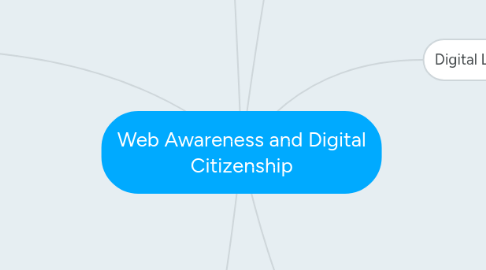
1. Digital citizenship
1.1. Need Education
1.1.1. Web Safety
1.1.1.1. Privacy settings
1.2. Respect
1.2.1. Yourself
1.2.2. Others
1.2.2.1. Credibility
1.2.2.2. Identity
1.2.2.3. "Think before you click"
1.2.3. Intellectual Property
1.2.3.1. Authorship
1.2.3.2. Ownership
1.2.4. Other property
1.3. Protect
1.3.1. Yourself
1.3.2. Others
1.3.3. Intellectual property
2. Elements
2.1. Digital Access
2.1.1. Electronic participation
2.1.1.1. Equal rights
2.2. Digital Communication
2.2.1. Information Exchange
2.2.1.1. Constant communication
2.2.2. Modes
2.2.2.1. Cell phones
2.2.2.2. Email
2.2.2.3. Instant Messaging
2.3. Digital Literacy
2.3.1. Learning technology
2.3.2. Using technology
2.4. Digital Law
2.4.1. Responsibility
2.4.1.1. Actions
2.4.1.2. Deeds
2.4.2. Technological Ethics
2.4.2.1. Crime
2.4.2.1.1. Theft
2.5. Digital Health and Welness
2.5.1. Physical/psychological well-being
2.5.1.1. Eye safety
2.5.1.2. Ergonomics
2.5.1.3. Repetitive stress
2.5.1.4. Internet addiction
2.6. Digital Security
2.6.1. Safety precautions
2.6.1.1. Virus protection
2.6.1.2. Data backups
2.6.1.3. Surge control
3. Authenticity of Web Resources
3.1. Evaluating
3.1.1. Authority
3.1.1.1. Who Owns it
3.1.2. Coverage
3.1.2.1. Material relevance
3.1.3. Objectivity
3.1.3.1. Bias
3.1.4. Accuracy
3.1.4.1. Reliable
3.1.4.2. Error Free
3.1.5. Currency
3.1.5.1. Up to Date
3.2. Marketing
3.2.1. Pester power
3.2.1.1. child Influence
3.2.1.2. Child autonomy
3.2.2. Brand Name Loyalty
3.2.3. Commercialization in Schools
3.2.3.1. Schools need money
3.2.4. Adult Entertainment to kids
3.2.5. The internet
3.2.5.1. Youth Culture
3.2.5.2. Limited Supervision
3.3. Privacy
3.3.1. Selective Publishing
3.3.1.1. Audience
3.3.1.2. Anonymity
3.3.1.3. Permanence
3.3.1.4. Copyright
3.3.1.5. Free Speech
4. Digital Literacy
4.1. Ethical behaviour
4.1.1. Identity
4.1.1.1. Cyber bullying
4.1.2. Privacy
4.1.3. Ownership
4.1.4. Trustworthiness
4.1.5. Participation
4.1.5.1. Consume media
4.1.5.2. Create media
5. Web Awareness
5.1. Internet Safety
5.2. Cyberbullying
5.2.1. Outside legal reach of schools
5.2.2. Defamatory Libel
5.2.3. Netiquette
5.2.3.1. Technology etiquette
5.2.3.2. Code of conduct
5.2.3.2.1. Socially acceptable
5.2.4. Amanda Todd
5.3. Sexually Explicit Material
5.3.1. Misguided Acceptance
5.3.2. Premature Sexualization
5.3.3. Interferes with healthy sexual development
5.4. Teacher Web Awareness
5.4.1. In Loco Parentis
5.4.1.1. Teacher = guardian
5.4.1.1.1. Unoffical
5.4.2. Target Marketing
5.4.3. Netiquette
5.4.4. Web Safety
5.4.5. "Think before you click"
5.4.6. Copyright Law
6. Copyright
6.1. Intellectual Property
6.1.1. Invention/Artistic creation
6.2. Public domain
6.2.1. permission not needed
6.3. Fair use
6.3.1. Parodying existing work
6.3.2. Quoting
6.4. Teachers role
6.4.1. Modelling
